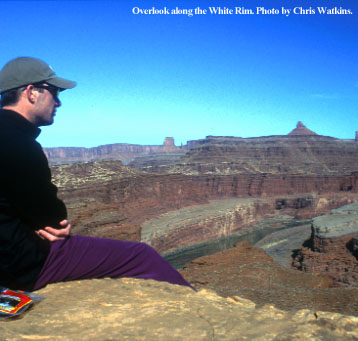
See our Moab area overview and Moab area hikiing articles.
By Golden Webb
In 1859, Captain J.N. Macomb of the U.S. Corps of Topographical Engineers was assigned to locate the confluence of two of the nations mighty rivers, the Colorado and the Green. Wandering around in the vicinity of what is now the Needles District of Canyonlands, he reported that he could not "conceive of a more worthless and impracticable region than the one [he] now found [himself] in."
But his initial revulsion was short-lived. Soon enough he was waxing poetic about the undeniably beautiful Needles, " . . . a long line of spires of white stone, standing on red bases, thousands in number, but so slender as to recall the most delicate carving in ivory or the fairy architecture of some Gothic cathedral; yet many, perhaps most, were over five hundred feet in height, and thickly set in a narrow belt or series some miles in length. Their appearance was so strange and beautiful as to call out exclamations of delight from all our party." The captain never did find the Confluence. The land was too rough, "impassable to everything but the winged bird."
Not much has changed since 1859. Our notions of worth and practicability have evolved a bit, and a few 4WD tracks have been pushed down in amongst the "impassable" pinnacles and canyons, but on the whole the land that frustrated, turned back, and ultimately defeated J.N. Macomb has remained virtually unaltered since the 19th Century. Indeed, the land is much the same as it was when the Ancestral Puebloans (Anasazi) hunted and farmed there a thousand years ago.
This happy fact is due in large part to Canyonlands' inaccessibility. Two great rivers flow together at its heart, and the arterial erosion of the canyons and gorges draining into this living, beating heart has shaped and carved a land as rugged and difficult to span as any other in the lower 48. We're talking mile upon endless mile of multicolored slickrock like umber skin stretched to the breaking over knobby, jutting ribs and spines and bones of rock, over the very skeleton of the earth. Access roads skirt the borders of this impossible landscape but only suspension-slamming, axle-grinding, virtually impassable 4WD tracks cut into its depths. Most people content themselves with driving to one of the many overlooks about the edges, taking a peek over the brink, then hightailing it back to Moab before the Back of Beyond bookstore closes, where they buy the latest Tom Till coffee table book and call it good. This is too bad, because many of Canyonlands' most enchanting features, its secret arches and hidden alcoves, its hanging gardens and trickling seeps, its stunning ruins and haunting petroglyphs, are hidden away down there, down in the deeps, tucked into and under and between the twisting corridors of stone.
